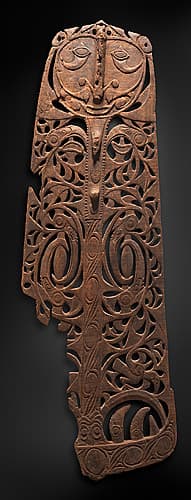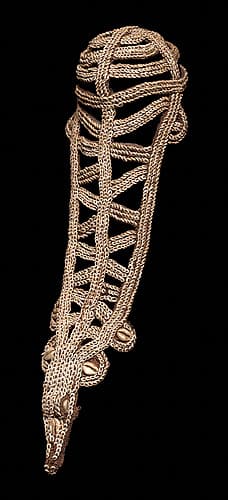About the exhibition
This exhibition showcases the unique cultures of the Sepik River region of Papua New Guinea, a country that has been part of Australia's history and will very much be part of its future. Myth and magic opens as Papua New Guinea celebrates its 40th anniversary of independence.
 Sawos people
'Malu' plaque 19th century, wood. National Gallery of Australia, Canberra, purchased 1977.
Sawos people
'Malu' plaque 19th century, wood. National Gallery of Australia, Canberra, purchased 1977. Unlike the homes of other great works in Australia's national art collection, this beautiful part of Papua New Guinea is seldom visited. The wilds of the Sepik River and its southern tributaries—the Blackwater, Korewori, Yuat and Keram rivers—are not your typical tourist destinations. And yet, the Sepik River is one of the largest river systems in the world and is home to an array of art-producing communities distinguished for their visual arts, including sculptures of supernatural beings, masks and other fascinating objects that beguile and bewilder all who encounter them.
Sculptures of crocodiles can be larger than life-size; some are the length of four people, as is the case of the colossal spirit crocodile figure from the Korewori River on loan to the National Gallery of Australia from the National Museum and Art Gallery of the Papua New Guinea. Australia's national collection includes a ceremonial house post covered in carved designs of crocodile scales, and even an exquisite bridal veil (ambusap), from the collection incorporates the crocodile motif. Traditional jewellery from the Sepik River is among the most ornate in Melanesia, and the veil, which terminates in a woven crocodile head, shows the tightest hand-binding technique and great attention to detail in the application of hundreds of tiny nassa shells.
 Iatmul people
Ambusap (bridal veil) mid 20th century, shell, fibre. National Gallery of Australia, Canberra, purchased 2008.
Iatmul people
Ambusap (bridal veil) mid 20th century, shell, fibre. National Gallery of Australia, Canberra, purchased 2008. The art of the region is bewilderingly inventive through the use of so many varied materials: pig tusks; feathers; worked and polished shells; clay; human, animal and fish bones, hair and teeth; wood; the fur and skins of opossums and flying foxes; fibre and a vibrant palette of ochres.
Each community has its own artistic canon, history and cosmology. According to an origin myth of the Iatmul people, who live along the banks of the middle length of the river, the world was created by a primordial crocodile that swam everything into being. Every time the floods came, it was thought to be the primal crocodile settling down into the waters, as the land and the crocodile's back are one and the same. Earthquakes were signs that the crocodile was moving. The jaws of a crocodile symbolically represent this worldview: the upper jaw is the sky and all within it and the lower jaw is the land and the river and everything upon and in it.
Special events: National Film and Sound Archive
National Film and Sound Archive also have a number of special events and screenings in connection with the 40th anniversary of independence of Papua New Guinea. nfsa.gov.au/calendar/
Although the once culturally accepted practice of headhunting ceased in the early twentieth century, life along the Sepik continues much as it has done for centuries. Cooked sago is still a staple food and the ubiquitous dugout wooden canoes continue to be made and used for travel and fishing. Each community still has a strong sense of identity defined by pre-Christian myths and oral histories, and they continue with traditional cycles of events such as initiations and, to a lesser extent than the first half of the twentieth century, the creation of extraordinary ceremonial arts.
Myth and magic is an exceptionally rare opportunity to encounter Sepik masterpieces, works of art that speak of a time and a place where spirits and ancestors were integral to daily life. The National Museum and Art Gallery of Papua New Guinea has generously lent five of its masterpieces yet the majority of these works come from the exceptional collections of Australian museums and art galleries. Many works on display have never been shown before.
Open 7 Aug – 1 Nov 2015 Canberra only
Free admission

